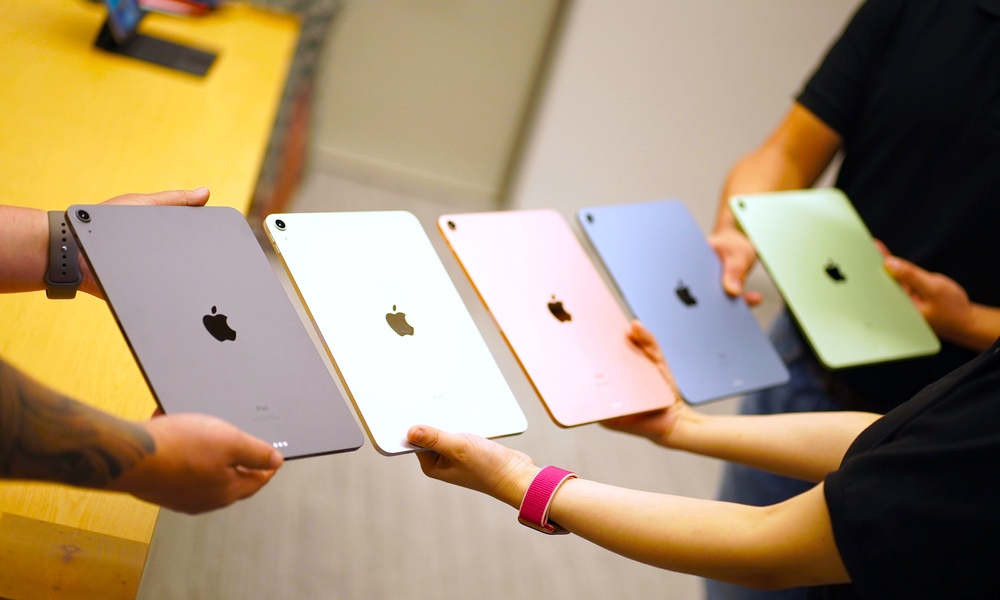Apple’s ‘iPad Air 5’ May Skip the A15, Head Straight Into M1 iPad Pro Territory
 Credit: Jack Skeens / Shutterstock
Credit: Jack Skeens / ShutterstockToggle Dark Mode
By now, it’s almost a sure thing that Apple will announce a new fifth-generation iPad Air tomorrow, but what’s surprising is that it might just leapfrog the iPad mini 6 entirely and go straight into iPad Pro territory.
Most folks have assumed that the iPad Air 5 would follow in the footsteps of its 2020 predecessor, moving from an A14 chip to an A15 chip, restoring the balance to Apple’s mid-tier tablet lineup by putting it back on par with its smaller iPad mini counterpart.
After all, that’s how things looked in early 2019, when Apple created an entire new middle tier in the iPad family with the introduction of the third-generation iPad Air and fifth-generation iPad mini. While these generational designations were appropriate for Apple’s naming standards, they both changed the iPad landscape significantly enough to have little in common with the predecessors beyond their names.
When Apple released the iPad Air 4 in 2020, it jumped ahead of the iPad mini by moving to the same A14 chip found in the iPhone 12 lineup. A year later, the iPad mini 6 leaped ahead by getting the A15 chip of the iPhone 13 lineup.
Now, however, it looks like the iPad Air is about to take a massive leap beyond that, with a new exclusive report from 9to5Mac revealing that Apple is about to release the new fifth-gen iPad Air with nothing less than the same M1 chip found in the iPad Pro, MacBook Air, and 13-inch MacBook Pro.
Based on information seen by 9to5Mac, iPad Air 5 (codenamed J408) will have the same M1 chip that Apple uses in the 2021 models of the iPad Pro and also in the first generation of Apple Silicon Macs, which includes the 24-inch iMac and 2020 MacBook Air.Filipe Espósito, 9to5Mac
A More Powerful iPad Air
As surprising as this may sound, it’s actually not that far-fetched.
Firstly, nobody saw the M1 coming to the iPad Pro last year. At the time, the so-called smart money was on an A14X — a souped-up version of the A14 that would have followed the same pattern as prior iPads. The 2018 iPad Pro came on the heels of the A12-equipped iPhone XS/XR and included an A12X, and the early 2017 iPad Pro lineup used the A10X, based on the A10 found in the late 2016 iPhone 7.
However, Apple blindsided us last year when it introduced the iPad Pro with the actual M1 chip. While the jury is still out even a year later on how necessary that is in a device that runs iPadOS rather than macOS, there’s no doubt that it allows the iPad Pro to pack in unprecedented performance.
With the M1 Pro and M1 Max have already upped the stakes, and Apple most likely set to debut the M2 tomorrow, the M1 is also kind of yesterday’s news. The iPad Pro will almost certainly get a better chip this year — likely moving to the M2 — so there’s no harm in putting the M1 into the iPad Air 5.
The iPad Pro also has a lot more going for it to set it apart from the iPad Air, and it’s unlikely that Apple considers raw performance to be the main differentiator. After all, the iPad Air 4 already pulled out ahead of the 2020 iPad Pro when it debuted with an A14 chip only six months after the flagship model came along with an A12Z — which was only a minimally upgraded version of the 2018 A12X.
However, even though the iPad Air 4 scored higher in benchmarks, even 2018 iPad Pro users weren’t rushing out to “upgrade” to the iPad Air. Features like Face ID, higher storage capacities, a ProMotion display, and a better camera system all kept the iPad Pro well ahead of its lower-priced siblings, even if they did have faster chips.
Of course, Apple also rectified that a few months later with the debut of the M1 iPad Pro, putting its premium tablet in a class by itself. However, the 2021 iPad Pro still offers all the same advantages over the iPad Air as it did before — plus an even more incredible mini-LED display on the 12.9-inch model — and it’s unlikely any of those things are coming to the iPad Air 5 tomorrow.
In fact, from everything we’ve heard, the iPad Air will otherwise remain mostly the same as its fourth-generation predecessor while getting the enhancements that have come to the iPad mini 6. That includes 5G support, of course, which is a given at this point, as well as a new front camera to offer the Center Stage feature — something that even the entry-level 9th-generation iPad has going for it now.
Other features like Face ID, ProMotion, the multi-camera system with LiDAR, and Thunderbolt/USB 4 support are likely to remain the exclusive domain of the iPad Pro.
While we’ve heard nothing about storage capacities for the iPad Air 5, it’s a safe bet that those won’t reach the level of the iPad Pro either; the iPad mini 6 caps out at 256GB, while the iPad Pro is available in configurations of up to 2TB.
[The information provided in this article has NOT been confirmed by Apple and may be speculation. Provided details may not be factual. Take all rumors, tech or otherwise, with a grain of salt.]






